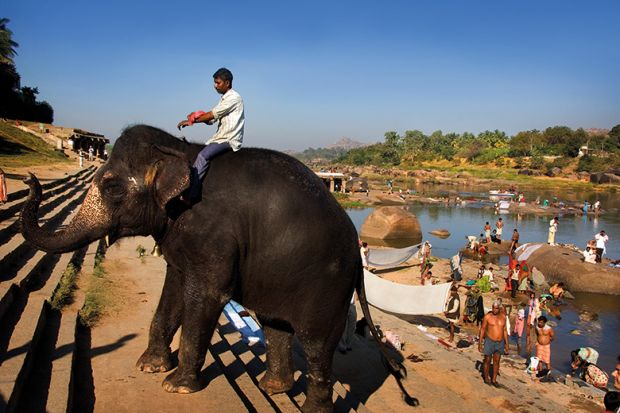A plan by India to create 20 domestic “institutions of eminence”, with potentially significant implications for the country's place in global higher education, has been hailed as a more sustainable development model than shelved plans to invite in foreign universities.
However, commentators have warned that India faces huge challenges over autonomy and funding if the proposals are to succeed.
Developments in Indian higher education – the second largest sector in the world in terms of student numbers – could potentially have a huge impact on universities around the world, if plans to increase the quality of its domestic universities alter global student flows or bring new opportunities for international collaboration.
The Cabinet of India’s previous Congress-led government approved a Foreign Education Providers Bill, providing a framework allowing overseas universities to establish branch campuses in India, in 2010. But the plan, a bid to drive up quality in Indian higher education, was first blocked by Communist lawmakers then became bogged down when introduced to Parliament.
Last week, the Indian business newspaper Mint quoted two government officials as saying that the idea had been shelved. “There is no work happening on that; instead the government will give more thrust to the domestic world-class university plan,” said one official quoted.
Plans to selectively fund 10 public and 10 private Indian institutions, which would be allowed to recruit up to 30 per cent of their student body from overseas and would have the aim of becoming “world-class teaching and research institutions”, were first announced last year.
Human resource development minister Prakash Javadekar said last month that the institutions selected – by methods yet to be fully confirmed – would be known as “Indian institutes of eminence” (replacing the earlier “world-class university” tag).
The Foreign Education Providers Bill would have allowed only “top 400” ranked institutions to set up in India and imposed strict financial limitations on their operation.
“The Indian bill was certainly the most evident manifestation of the concern that the importing country may be taken advantage of by the foreign institution,” said Jason Lane, a transnational education expert and chair of the department of educational policy and leadership at the State University of New York Albany.
“However, it went to an extreme and created an environment where it was near impossible for an international branch campus to be successful.”
Kevin Kinser, professor of education at Pennsylvania State University, said that “while it would be a huge boost if India opened its doors”, most foreign universities “have been cautious about the possibility and would have tread lightly in any case, because the policy landscape [in India] is notoriously unreliable”.
Expert observers of Indian higher education see the domestic “institutions of eminence” plan as a more sustainable option for India’s long-term development.
Devesh Kapur, Madan Lal Sobti professor of contemporary India at the University of Pennsylvania, and co-editor of the recent Navigating the Labyrinth: Perspectives on India’s Higher Education, said the idea “that elite higher education institutions would rush into India (or for that matter anywhere) in any serious way without big bucks is a complete delusion”.
The “institutions of eminence” plan “is a much better idea – at least in principle”, Professor Kapur suggested. If implemented correctly, each of these institutions “will themselves form partnerships with good institutions around the world, whether twinning, faculty/student exchanges, joint research projects”, he suggested.
His co-author on Navigating the Labyrinth, Pratap Bhanu Mehta, former president of India’s Centre for Policy Research thinktank and now vice-chancellor of Ashoka University, agreed that the foreign providers plan had been a “pipe dream”. But he added that key challenges in the domestic plan are whether the institutions selected are “given the requisite degree of autonomy”, particularly for universities under the authority of state, rather than central, governments.
Other challenges are the “credibility of regulators”, the selection process for institutions of eminence, along with the strength of India’s economy affecting resources and investment for those institutions, Dr Mehta said.
A budget of 10,000 crore rupees (£1.2 billion) for the 10 public institutions has been approved.
Philip Altbach, research professor and founding director of the Center for International Higher Education at Boston College, said that the “institutions of eminence” plan “is intended to improve the top of the system – but the proposed funding is inadequate, and the deep problems of bureaucracy, politicisation and the pressure of numbers in the public university sector are significant challenges”.
He added: “Thus, it will take India a rather long time to stem the outflow of many of its best students to top universities overseas.”
The 20 universities will be granted freedoms including the ability to set their own fees for foreign students, scope to set their own salaries for foreign faculty in a bid to attract overseas talent and a degree of discretion in admissions. The government will set targets for average publication rates of staff in high-status international journals.
Register to continue
Why register?
- Registration is free and only takes a moment
- Once registered, you can read 3 articles a month
- Sign up for our newsletter
Subscribe
Or subscribe for unlimited access to:
- Unlimited access to news, views, insights & reviews
- Digital editions
- Digital access to THE’s university and college rankings analysis
Already registered or a current subscriber? Login







